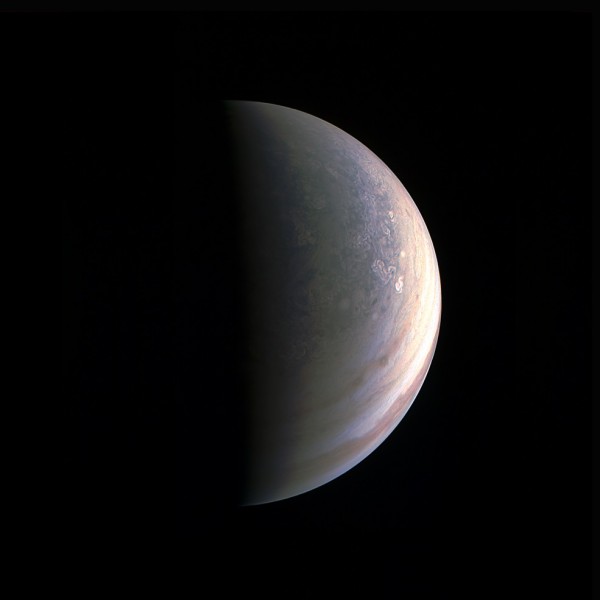By Ana Verayo, | September 06, 2016

NASA's Juno spacecraft captured this view as it closed in on Jupiter's north pole, about two hours before closest approach on Aug. 27, 2016.
Jupiter's north pole has been revealed for the first time, showing storm systems that are never seen before including weather patterns, courtesy of new imagery captured by NASA's Juno spacecraft, last week.
Like Us on Facebook
According to Juno principal investigator, Scott Bolton from the Southwest Research Institute, these are the first few glimpses of Jupiter's northern pole, and they are nothing we have seen or imagined before. He adds, it's more blue than any other regions of the planet, that is also covered in storms.
Juno recently completed 36 flybys of Jupiter last August 27, where mission scientists obtained these new photos taken some 2,600 above the surface of the gas giant. Scientists spent a day and a half downlinking six megabytes of fresh data from this latest orbital flyby, lasting a span of six hours.
Bolton notes that new imagery shows that there are no latitudinal bands or zones or belts that we are used seeing. This new image of the north pole is almost as if it's not part of Jupiter, where clouds have shadows, which means that they are possibly located in higher altitudes, he explains.
If Saturn possesses hexagon shaped storms on its north pole, Jupiter's storms are apparently vastly different from these, describes Bolton. Taken by the spacecraft's onboard JunoCam imager, mission scientists confirm that Jupiter is a truly unique planet from the rest in the solar system.
JunoCam, along with a suite of scientific instruments are now activated to collect crucial data about Jupiter's weather systems. One instrument known as the Jovian Infrared Auroral Mapper that maps the north pole with infrared light, revealed hot spots that were never seen by scientists before, including auroras.
According to Juno's JIRAM project Alberto Adriani of the Istituto di Astrofisica e Planetologia Spaziali in Rome, for the first time ever, these infrared views revealed Jupiter's southern auroras, as no other ground or space instruments can detect these auroras.
New JIRAM data shows how they are very bright, possessing a solid structure, which can provide more clues about the morphology and dynamics of the gas giant's natural phenomena.
Apart from north pole storms and south pole auroras, Juno was also able to record sound transmissions from these auroras, detected by Juno's Radio/Plasma Wave Experiment (Waves) experiment, as mission scientists analyzed them at this closest distance ever.
-
Use of Coronavirus Pandemic Drones Raises Privacy Concerns: Drones Spread Fear, Local Officials Say

-
Coronavirus Hampers The Delivery Of Lockheed Martin F-35 Stealth Fighters For 2020

-
Instagram Speeds Up Plans to Add Account Memorialization Feature Due to COVID-19 Deaths

-
NASA: Perseverance Plans to Bring 'Mars Rock' to Earth in 2031

-
600 Dead And 3,000 In The Hospital as Iranians Believed Drinking High-Concentrations of Alcohol Can Cure The Coronavirus

-
600 Dead And 3,000 In The Hospital as Iranians Believed Drinking High-Concentrations of Alcohol Can Cure The Coronavirus

-
COVID-19: Doctors, Nurses Use Virtual Reality to Learn New Skills in Treating Coronavirus Patients








